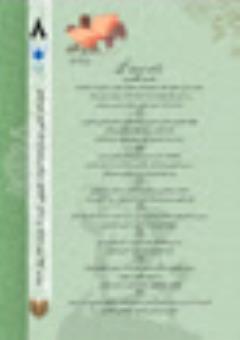Dedoxification of White Mythology: A Deleuzo-Baroquean Reading of Suzan-Lori Parks' The Imperceptible Mutabilities in the Third Kingdom
Subject Areas : Comparative Literature Studies
Sara Faryam Rad
1
![]() ,
Hassan Shahabi
2
,
Shahram Raeisi Sistani
3
,
Hassan Shahabi
2
,
Shahram Raeisi Sistani
3
1 - PhD candidate, Islamic Azad University, Kerman Branch
2 - Assistant Professor, Department of Humanities, College of English Language and Literature, Kerman Branch, Islamic Azad University, Kerman, Iran. (Corresponding author)
3 - Assistant Professor, Department of Foreign Languages, Shahid Bahonar University, Kerman, Iran.
Keywords: Becoming, Deleuzo-Baroquean, Dedoxification, Neo-baroque, Suzan-Lori Parks,
Abstract :
This article attempts to investigate the first major dramatic work of Suzan-Lori Parks from a new angle in suggesting the writer, like the Persian Shahrzad story-teller with interwoven stories/plays, narrates, through a Parksian labyrinthine folding structure, the lost history of African subordinated and discarded by History. Having a Deleuzo-baroquean perspective, this study explores the imperceptible or less-known aspects of her drama that have been muted throughout the White mythological historicism. She portrays, on her neo-baroquean canvas, an amalgamation of myth, music, and performance, while her figures, dis-figured by the dominant discourse, become the schizophrenic bodies that subvert the ruling system in a rhizomatic manner. Moreover, her polyphonic lines of flight in the form of Jazz syncopation, contrapuntally, recite the saga of African-American oppressions. In the end, it is concluded that Parks, as a female African-American playwright, has distinguished her dramatic works from her contemporaneous by designating the Deleuzo-baroquean plateau in her first play, a tool for subverting and undermining the dominant discourse, in the trajectory of Shahrzad's flight to save her dramatic life.
References
1. Bennet, Michel Y (2017). "The Chorus 'Inbetween': 'Rep and Rev[ing]' Athenian Drama in Suzan-Lori Parks' Imperceptible Mutabilities in the Third Kingdom". Journal of Dramatic Theory and Criticism. Vol. 32, No.1, U of Kansas.91-106.
2. Braidotti, Rosi (2010). "Schizophrenia". The Deleuze Dictionary. Ed. Adrian Parr. Edinburgh: Edinburgh UP. 237-239.
3. Callaway, Stephen (2000). Baroque Baroque. Pheidon Press. Print.
4. Colebrook, Claire (2002). Gilles Deleuze. London: Routledge. Print.
5. ---. (2002). Understanding Deleuze. Midland: Allen. Print.
6. Deleuze, Gilles (1993). The Fold, Leibniz and the Baroque. London: Continuum. Print.
7. ---. (1985). Cinema2: The Time-Image. Trans. Hugh Tomlinson and Robert Galeta. France: Les Editions de Miniuit. Print.
8. Deleuze, Gilles, and Felix Guattari (1983). Anti-Oedipus: Capitalism and Schizophrenia. U of Minnesota P. Print.
9. ---. (1987) A Thousand Plateaus: Capitalism and Schizophrenia. Trans. Brian Massumi. Minneapolis: U of Minnesota P. Print.
10. Dimakopoulou, Stamatina (2006). "Remapping the Affinities between the Baroque and the Postmodern: The Folds of Melancholy & the Melancholy of the Fold". Discourse of Melancholy. Revue électronique d'études sur le monde anglophone.
11. Egginton, William (2010). The Theater of Truth: The Ideology of Neo-Baroque Aesthetics. California: Standford U P. Print.
12. Garland, Sarah (2007). "Second Sight: Reading Twentieth-Century Self-Reflexive Fiction Through the Baroque." Intertext 7.3. U of East Angelina.
13. Garret, Shawn M (2007). "Figures, Speech, and Form in Imperceptible Mutabilities in the Third Kingdom". Suzan-Lori Parks: A Casebook. Eds. Kevin J. Wetmore and Alycia Smith Haward. Routledge: London.42-70.
14. Harbinson, Robert (2003). Reflections on Baroque. Chicago U P. Print.
15. Hills, Helen et al (2015). "Conceptions and Reworkings of Baroque and Neo-baroque in Recent Years." In Perspective: Actuallité en histoire de l'art. Institut national d'histoire de l'art. Tr. Suzan Wise. 43-62.
16. Lorraine, Tamsin (2010). "Lines of Flight". The Deleuze Dictionary. Ed. Adrian Parr. Edinburgh: Edinburgh UP. Print. 144-146.
17. Message, Kylie (2010). "Body Without Organ". The Deleuze Dictionary. Ed. Adrian Parr. Edinburgh: Edinburgh UP. 32-34.
18. Moradi, Moein et al (2020-2021). "Villain-Becoming and Body without Organs: A Deleuze-Ghattarian Rhizoanalysis of Paul Auster's Invisible." Cultural Literary Studies. Vol. III, No.1, Series 5. 55-67.
19. Mudasir, Mufti (2014). Towards a Poetics of Postmodern Drama: A Study of Harold Pinter and Tom Stoppard. Cambridge Scholars Publishing.
20. Ndalianis, Angela (2004). Neo-Baroque Aesthetics and Contemporary Entertainment. Massachusetts Institute of Technology. Print.
21. O'Sullivan, Simon (2010). "Fold". The Deleuze Dictionary. Ed. Adrian Parr. Edinburgh: Edinburgh UP. Print. 102-104
22. Parks, Suzan-Lori (1995a). "An Equation for Black People Onstage." The America Play and Other Works. New York: Theatre Communications Group. 19-22.
23. ---. (1995b) "From the Elements of Style." In The America Play and Other Works. New York: Theatre Communications Group. 6-18.
24. ---. (1995c) The Imperceptible Mutabilities in Third Kingdom. The America Play and Other Works. New York: Theatre Communications Group.
25. ---. (1997) Venus. New York: Theatre Communications Group.
26. Parr, Adrian, ed (2010). The Deleuze Dictionary. Edinburgh: Edinburgh UP. Print.
27. Roffe, Jonathan (2010). "Nomos". The Deleuze Dictionary. Ed. Adrian Parr. Edinburgh: Edinburgh UP.184-186.
28. Smiešková, Alena (2010). "In Lieu of an Introduction, the Baroque Space in Paul Auster's City of Glass". In ARS AETERNA – Unfolding the Baroque: Cultures and Concepts. Chief editor Alena Smiešková. Univerzita Konštantína Filozofa v Nitre Filozoická fakulta. 9-15.
29. Snyder, Jon R (2010). "The Culture of Disfiguration: Anamorphosis, Then and Now". In ARS AETERNA – Unfolding the Baroque: Cultures and Concepts. Chief editor Alena Smiešková. Univerzita Konštantína Filozofa v Nitre Filozoická fakulta. 16-27.
30. Solomon, Alisa (2008). "Language in Last Black Man." In The Bedford Introduction to Drama, ed. Lee Jacobus. Boston, MA: Bedford/St. Martin's.
31. Vanhaesebrouck, Karel (2016). "Reconsidering Metatheatricality: Towards a Baroque Understanding of Postdramatic Theater." In Neo-Baroques: From Latin America to the Hollywood Blockbuster. Editor: Walter Moser et al. Rodopi.48-75.
32. Zamora, Loris Parkinson (2018). "Trompe l'oeil Technique: Borges' Baroque Illusionism". In Magic Realism & the New World Baroque. University of Houston.


